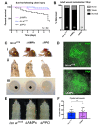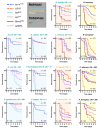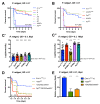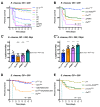Synergy and remarkable specificity of antimicrobial peptides in vivo using a systematic knockout approach
- PMID: 30803481
- PMCID: PMC6398976
- DOI: 10.7554/eLife.44341
Synergy and remarkable specificity of antimicrobial peptides in vivo using a systematic knockout approach
Erratum in
-
Correction: Synergy and remarkable specificity of antimicrobial peptides in vivo using a systematic knockout approach.Elife. 2019 May 28;8:e48778. doi: 10.7554/eLife.48778. Elife. 2019. PMID: 31135338 Free PMC article.
Abstract
Antimicrobial peptides (AMPs) are host-encoded antibiotics that combat invading microorganisms. These short, cationic peptides have been implicated in many biological processes, primarily involving innate immunity. In vitro studies have shown AMPs kill bacteria and fungi at physiological concentrations, but little validation has been done in vivo. We utilized CRISPR gene editing to delete all known immune-inducible AMPs of Drosophila, namely: 4 Attacins, 4 Cecropins, 2 Diptericins, Drosocin, Drosomycin, Metchnikowin and Defensin. Using individual and multiple knockouts, including flies lacking all 14 AMP genes, we characterize the in vivo function of individual and groups of AMPs against diverse bacterial and fungal pathogens. We found that Drosophila AMPs act primarily against Gram-negative bacteria and fungi, contributing either additively or synergistically. We also describe remarkable specificity wherein certain AMPs contribute the bulk of microbicidal activity against specific pathogens, providing functional demonstrations of highly specific AMP-pathogen interactions in an in vivo setting.
Keywords: AMP; D. melanogaster; Diptericin; Drosocin; Imd; Toll; immunology; inflammation; systemic immunity.
© 2019, Hanson et al.
Conflict of interest statement
MH, AD, CC, MP, SK No competing interests declared, BL Reviewing editor, eLife
Figures












Similar articles
-
Immune genes and divergent antimicrobial peptides in flies of the subgenus Drosophila.BMC Evol Biol. 2016 Oct 24;16(1):228. doi: 10.1186/s12862-016-0805-y. BMC Evol Biol. 2016. PMID: 27776480 Free PMC article.
-
Antimicrobial peptides in Drosophila: structures, activities and gene regulation.Chem Immunol Allergy. 2005;86:1-21. doi: 10.1159/000086648. Chem Immunol Allergy. 2005. PMID: 15976485 Review.
-
Drosophila immunity: the Drosocin gene encodes two host defence peptides with pathogen-specific roles.Proc Biol Sci. 2022 Jun 29;289(1977):20220773. doi: 10.1098/rspb.2022.0773. Epub 2022 Jun 22. Proc Biol Sci. 2022. PMID: 35730150 Free PMC article.
-
Drosophila sex-peptide stimulates female innate immune system after mating via the Toll and Imd pathways.Curr Biol. 2005 Sep 20;15(18):1690-4. doi: 10.1016/j.cub.2005.08.048. Curr Biol. 2005. PMID: 16169493
-
Resistance to antimicrobial peptides in Gram-negative bacteria.FEMS Microbiol Lett. 2012 May;330(2):81-9. doi: 10.1111/j.1574-6968.2012.02528.x. Epub 2012 Mar 12. FEMS Microbiol Lett. 2012. PMID: 22339775 Review.
Cited by
-
Dual proteomics of Drosophila melanogaster hemolymph infected with the heritable endosymbiont Spiroplasma poulsonii.PLoS One. 2021 Apr 29;16(4):e0250524. doi: 10.1371/journal.pone.0250524. eCollection 2021. PLoS One. 2021. PMID: 33914801 Free PMC article.
-
The mode of expression divergence in Drosophila fat body is infection-specific.Genome Res. 2021 Jun;31(6):1024-1034. doi: 10.1101/gr.269597.120. Epub 2021 Apr 15. Genome Res. 2021. PMID: 33858842 Free PMC article.
-
Anthrax toxin component, Protective Antigen, protects insects from bacterial infections.PLoS Pathog. 2020 Aug 31;16(8):e1008836. doi: 10.1371/journal.ppat.1008836. eCollection 2020 Aug. PLoS Pathog. 2020. PMID: 32866212 Free PMC article.
-
Lipopolysaccharide -mediated resistance to host antimicrobial peptides and hemocyte-derived reactive-oxygen species are the major Providencia alcalifaciens virulence factors in Drosophila melanogaster.PLoS Pathog. 2022 Sep 9;18(9):e1010825. doi: 10.1371/journal.ppat.1010825. eCollection 2022 Sep. PLoS Pathog. 2022. PMID: 36084158 Free PMC article.
-
The antimicrobial peptide defensin cooperates with tumour necrosis factor to drive tumour cell death in Drosophila.Elife. 2019 Jul 30;8:e45061. doi: 10.7554/eLife.45061. Elife. 2019. PMID: 31358113 Free PMC article.
References
-
- Asling B, Dushay MS, Hultmark D. Identification of early genes in the Drosophila immune response by PCR-based differential display: the attacin A gene and the evolution of attacin-like proteins. Insect Biochemistry and Molecular Biology. 1995;25:511–518. doi: 10.1016/0965-1748(94)00091-C. - DOI - PubMed
MeSH terms
Substances
LinkOut - more resources
Full Text Sources
Molecular Biology Databases

